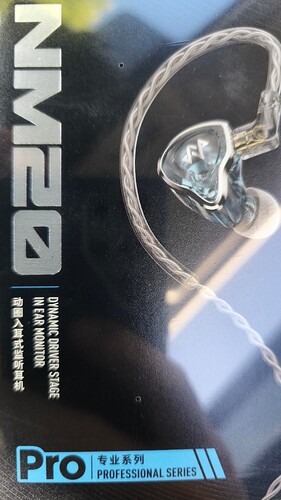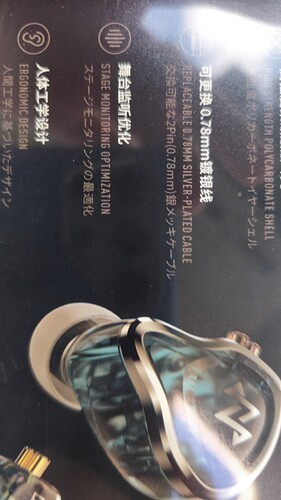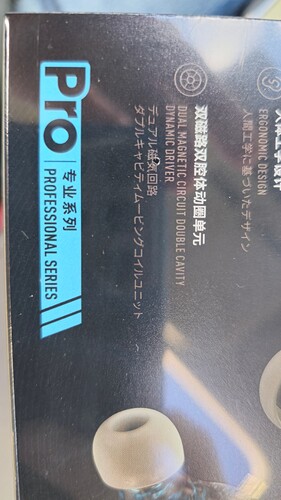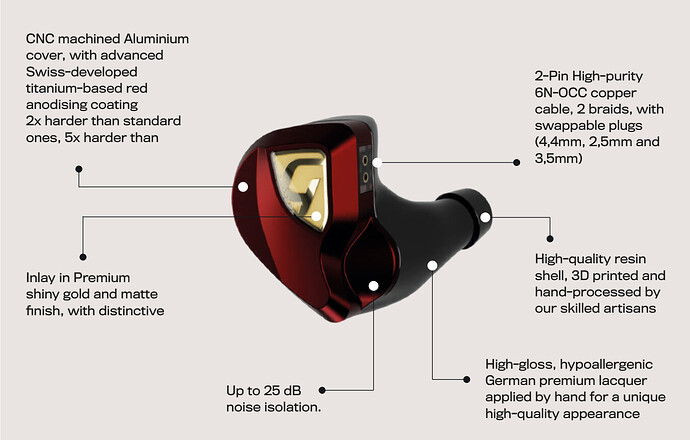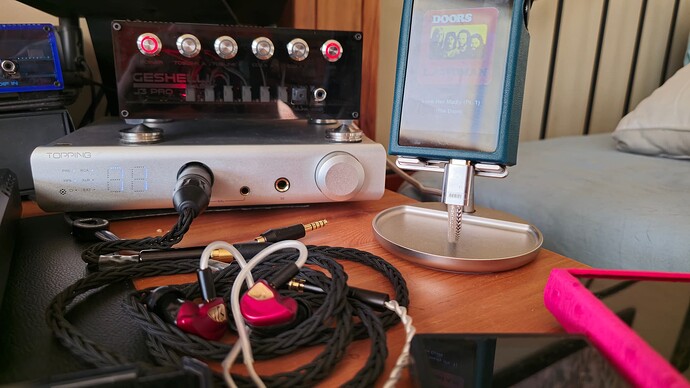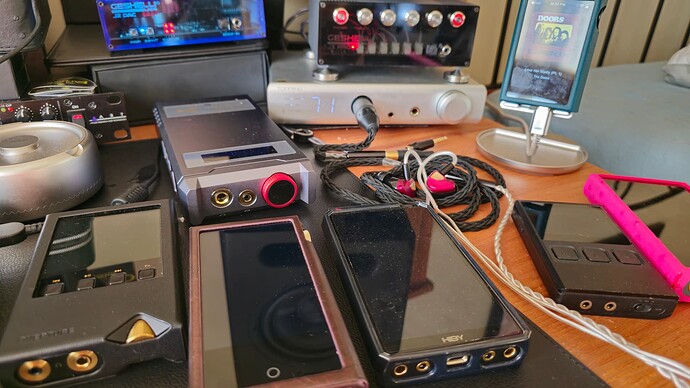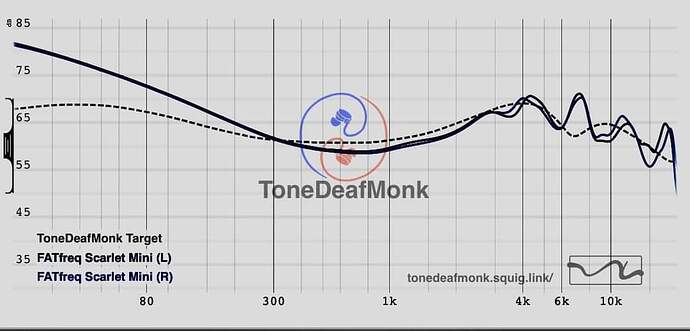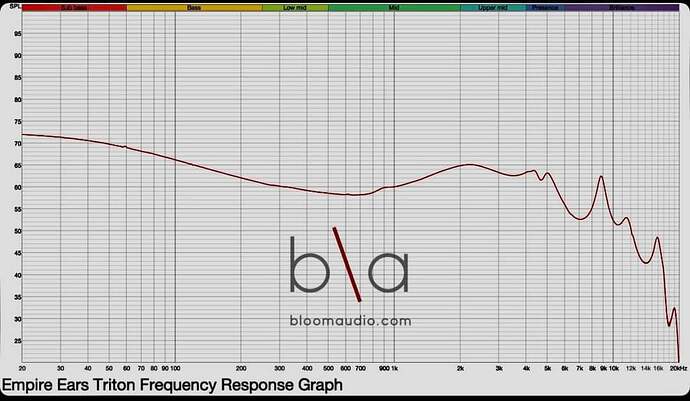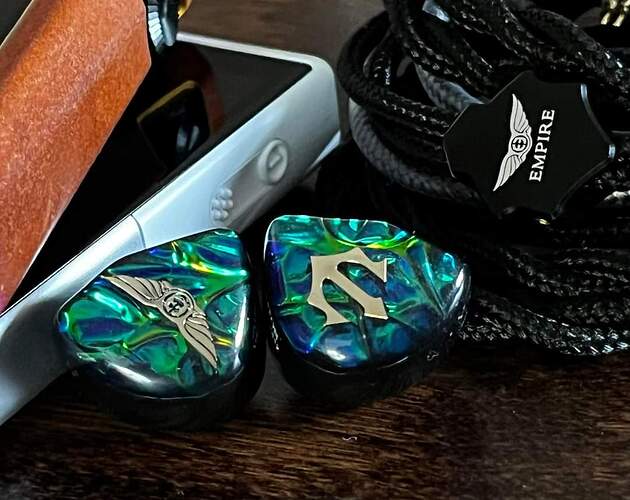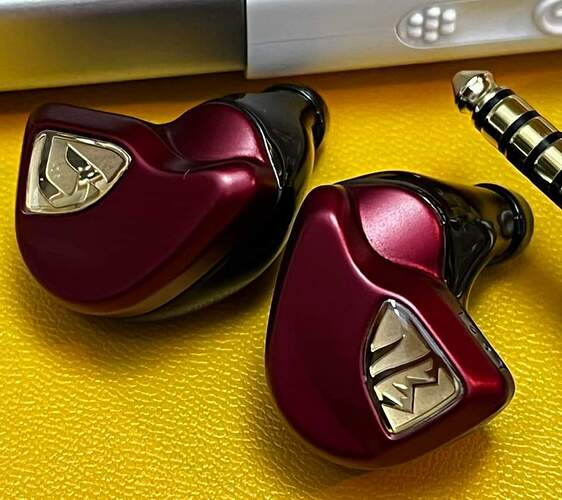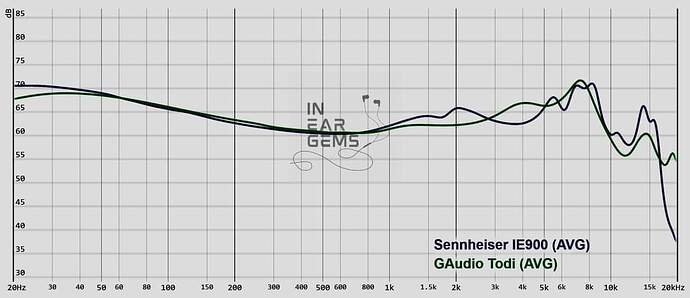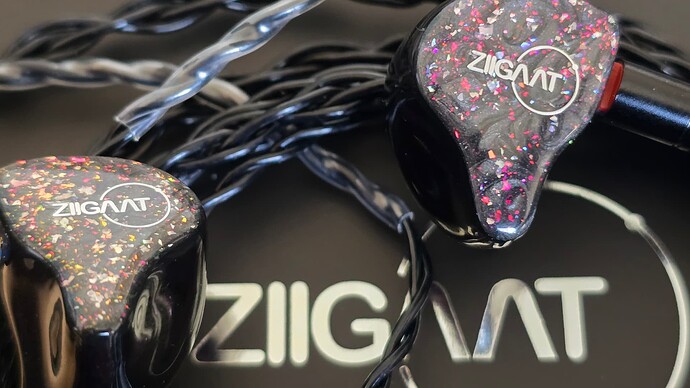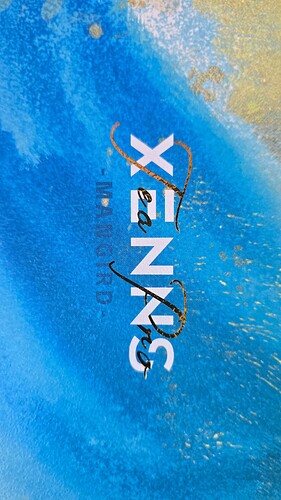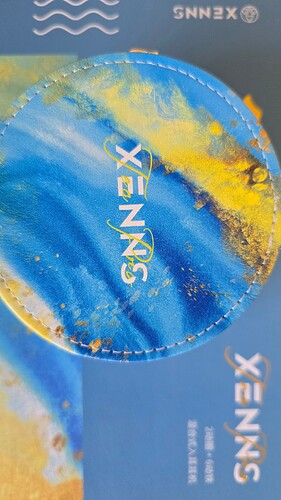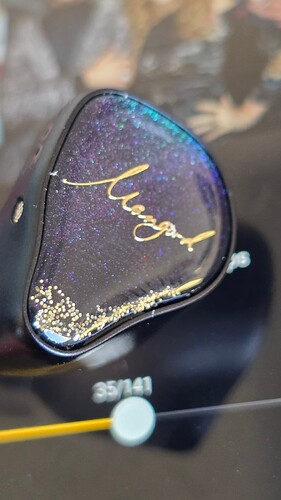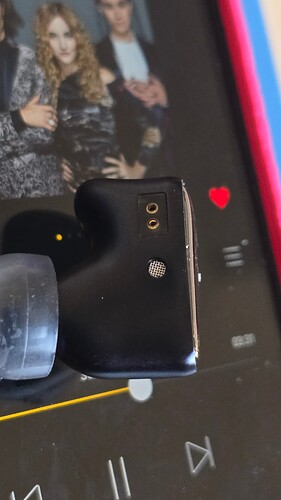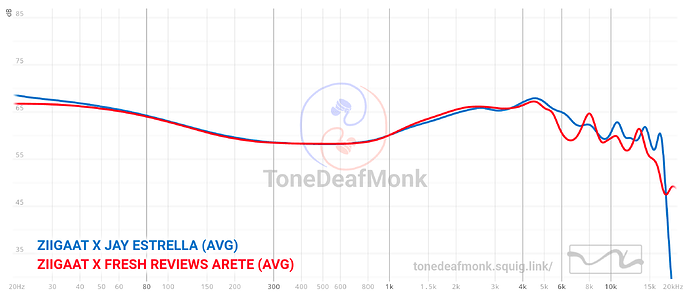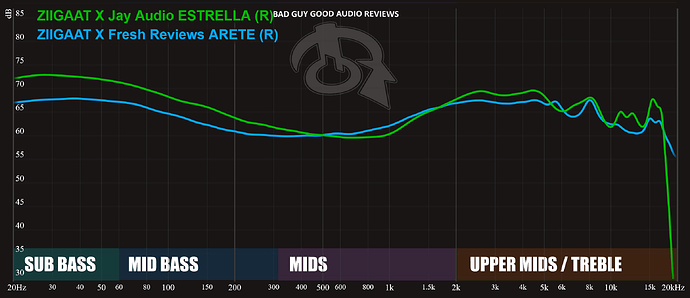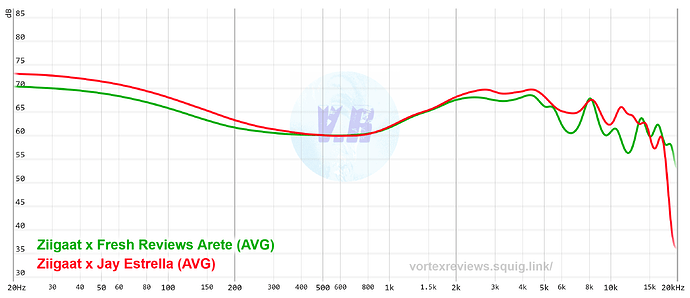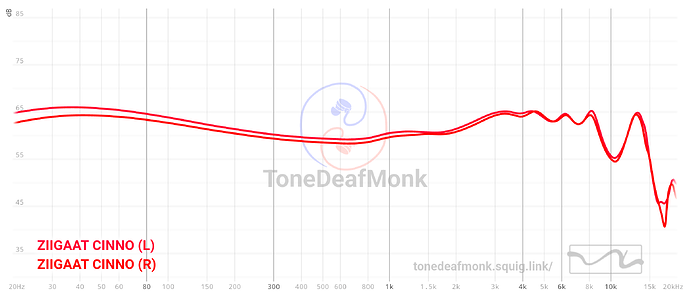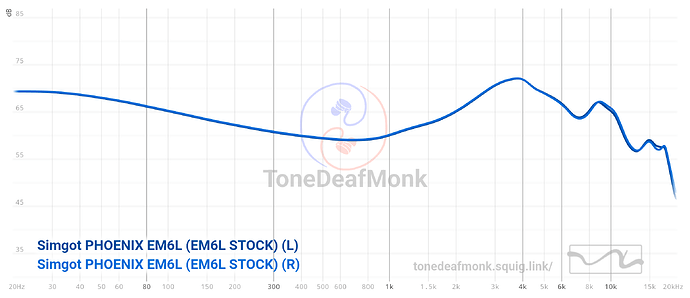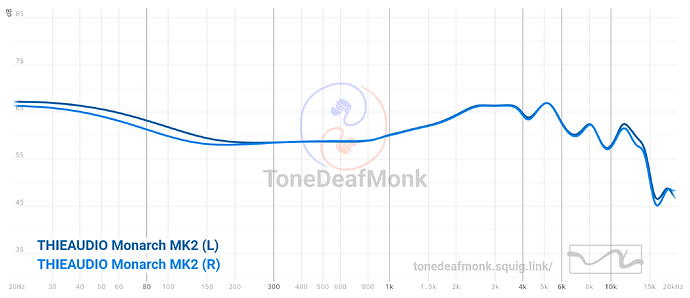The new NM20 from the rebranded NF ACOUS this one is from thier Professional Series made for stage monitoring.
Crisp , clean witha slightly elevated Upper mids for some outstanding Vocal and instrumental clarify upon first listen.
Here is a special one!
If you dont believe in sources your a fool!
Too bad more reviewers dont even mention thier sourse chain!
Do you have any measurable evidence of this difference on <1 Ohm sources or is it just your sensation? You said 8k peak is gone, so can you show it on FR graph?
Kevin’s Review of the new Empire Ears Triton:
Empire Ears Triton
VS
FATfreq Scarlet Mini
“Battle for the Bassgasm Crown”
Triton: $1800usd
Monarch Quinary 4.4mm cable.
1 qty W9+ Dynamic Sub Bass Driver.
1 qty EMP75 Balanced Armature.
2 qty Next Generation High-Mass Bone Conductors.
Impedance 2.8 ohms.
Sensitivity 99dB.
Scarlet Mini: $800usd
Upgraded red/silver 4.4mm cable.
1 qty 10mm Dynamic Driver.
1 qty Mids Balanced Armature.
1 qty Tubeless Super Tweeter Balanced Armature.
Impedance 38 ohms.
Sensitivity 106dB @ 1 kHz.
This is not a review, just a casual commentary sharing my experience comparing these two “Bass Canon” IEM’s.
110% biased toward my hearing, and my listening preferences.
Both IEM are fitted with their respective stock cables, and, Xelastec wide bore ear tips.
I choose the Astell & Kern SP2000T, 4.4mm out, set to Tube amp mode as my source device.
** note: Triton is notably easier to drive than Scarlet Mini.
I have listened to a wide variety of genres from the libraries on my SD card and Qobuz.
I will note the comparison track(s) used for each segment.
In a Nutshell:
Scarlet Mini V shape.
Triton U shape.
![]() Sub Bass:
Sub Bass:
Techmaster PEB - Bassgasm
Barley - Lizz Wright.
** Triton
On Bassgasm, the sub bass pulls low, boomy with a nice rumble. The BC drivers give the rumble a nice tactile feel.
On Barley, the sub bass doesn’t pull as low, and has more impact/less rumble.
Liz’s throaty, husky voice is clear and present. It sounds accurate and engaging.
** Scarlet Mini
On Bassgasm, the sub bass pulls notably lower than Triton. It’s thick and boomy. At higher volumes it has a tactile feel without BC drivers required.
The inside of your head feels like the inside of a sub bass cabinet.
On Barley, the sub bass is more boomy and less defined than Triton, turning up the volume to give the bass more impact results in the vocals bordering on shouty.
At more moderate volumes Liz’s voice is less prominent in the mix, but retains her throaty, husky charm.
![]() Conclusion:
Conclusion:
For outright sub bass presence, on a track that will deliver, Scarlet Mini takes the win.
For a more impactful sub/mid bass blend and better instrument and vocal tonality, Triton would be my choice.
![]() Mid Bass:
Mid Bass:
Daft Punk - Burning/Too Long Live
Sade - Cherish The Day
** Triton
On Burning, the bass has good rumble and impact, not a lot of definition between sub and mid bass but enough to add impact to the rumble.
On Cherish, one of my go to for sub/mid definition, there is consistent rhythmic kick drum presence, then around the 1:30 mark the bass guitar drops in.
There is reasonable separation between the kick drum and bass guitar.
I’ve heard much better, but it’s discernible.
Sade’s sultry voice benefits with some warmth carry over into the mids. Vocals sit low in the mix, but have good presence and tonality.
** Scarlet Mini
On Burning, Mid bass presence is scarce, Bass remains mostly sub focused, boomy with good rumble, but not much impact.
On Cherish, the kick drum is loose and more wump than thump. When the bass guitar drops in it pretty much absorbs the kick drum, and there is little or no definition between sub and mid bass.
Sade’s vocals sit low under the bass, it has more presence than Triton and sounds good, but is leaner, and brighter, than on Triton.
![]() Conclusion:
Conclusion:
Neither IEM is a mid bass superstar.
Scarlet Mini is unapologetically sub bass focused.
Triton has less sub bass extension, a bit more mid bass presence, and warmer vocals.
I have a preference for the Triton here, but, that is very much subject to personal preference.
![]() Mids and Vocals:
Mids and Vocals:
Dire Straits - Follow Me Home
** Triton:
Lower mids are recessed, tom and snare drums are present, but easily overshadowed by the sub bass, and by vocals and upper mids.
Upper mids and vocals fair quite well. They don’t “rise up” through the sub bass presence, rather they “push forward” through it. Upper mids detail is “relaxed” with good tonality. Not a lot of detail, but enough I don’t miss it when casually listening.
** Scarlet Mini:
Lower mids are almost absorbed by the sub bass. The only time tom and snare drums are clearly noticeable is when the sub bass is silent or relaxed.
Upper mids fair better. Similar to Triton, they are also relaxed and “push through” the bass. Scarlet Mini has a bit more energy in the upper mids, guitar and vocals stand out a bit more and display some added detail retrieval.
![]() Conclusion:
Conclusion:
The small amount of additional lower mids energy, combined with less sub bass bleed makes the Triton a bit more balanced than Scarlet.
Scarlet Mini’s ample sub bass combined with a bit more upper end energy solidifies its V shape tuning.
Personally, I lean toward Triton’s more balanced U shape tuning.
But there is a reasonable probability those who enjoy a good V tuning would lean toward Scarlet.
![]() Highs:
Highs:
Poncho Sanchez - Poncho Sanchez Medley #2.
** Triton:
The upper mids basically carry the upper end, in addition to a 9K peak that adds some air and sparkle.
The sub bass is less prominent on this track. Mids are less subdued, piano, horns, drums, vocals, and other instruments have good presence and nice tonality.
At around the 3:00 mark there is a flute solo that lasts about a minute. It is able to soar above the sub bass and is clear and detailed with no harshness or sibilance.
** Scarlet Mini:
Scarlet says “nope”, no one subdues my Sub bass!
Well, it is tightened up a bit, but that 30dB bass shelf is there for a reason.
Mids do manage a bit more presence, but piano, and horns not as present as on Triton. Tonality is good.
The highs definitely have more energy and detail than Triton.
They are also mostly carried but the upper mids, but the tubeless super tweeter, and a peak at 7k, shine on this track. At higher volumes they can be border line harsh.
![]() Conclusion:
Conclusion:
The Triton is more polite on this track, and I found listening to my library it was more versatile with a wider selection of genres.
The Scarlet stays true to its bass head and V shaped roots.
I had to keep the volume a bit lower on this track to keep the V from getting away on me.
![]() Head Stage:
Head Stage:
Head stage is similar enough on both IEM’s I will cover them together.
Both have head stage filling bass presence.
Both have good width, and height. The way the upper mids tend to play “out” forward from the bass provides a good sense of holographic depth.
Neither have spectacular imaging or layering due to mids and highs lacking strong detail retrieval proficiency.
Final Thoughts:
Both IEM’s are worthy of bass head status.
The question as to which does it better would come down to personal preference.
IMO the Triton has better quality bass overall with at least some extra sub/mid bass definition.
But Scarlet undoubtedly hoists the cup for most bass quantity.
Both have their merits, if, you like a lot of bass, and, if, you are willing to sacrifice some mids detail and high end micro detail to have it.
So… who wears the Bassgasm crown?
Personally I prefer listening to the Triton. For me it sounds more refined, and works with a more diverse range of genre. I can enjoy long listening sessions with ease.
Scarlet Mini coaxes you to push up the volume to get head shaking bass, which is great, but I fatigue sooner listening to Scarlet.
But….. It’s all about the bass….
![]()
![]() Scarlet Mini.
Scarlet Mini.
For unapologetic brain mushing bass.
My Music Sources:
Qobuz, and, FLAC and DSD files stored on the SD cards of my daps.
My music genre are primarily Rock, Blues, Jazz, Symphonic, Country, Rap, R&B, Pop, Electronic.
Enjoy your music. ![]()
And Original Review
EMPIRE EARS TRITON
LAUNCH EDITION
An unwavering Basshead joy ride.
Tribrid IEM.
1qty W9+ Dynamic Sub Bass Driver.
1 qty EMP75 Balanced Armature.
2 qty Next Generation High-Mass Bone Conductors.
-impedance 2.8 ohms.
-sensitivity 99dB
![]() Empire Ears Triton will tour with the Canuck Audioholics.
Empire Ears Triton will tour with the Canuck Audioholics.
Tone Deaf Monk
Kyle Parker
Bennett Kelly
I don’t go into detail on packaging, suffice it to say packaging is upscale and on par with Empire Ears standards.
IEM’s, quality cable, metal canister style case, 5 pair Final E series ear tips.
Launch addition includes an additional blue leather puck style case and a carry bag.
Pros:
![]() Quality resin shells are medium large size with fairly long nozzles. They fit and anchor well in my ears with a mid to deep insertion.
Quality resin shells are medium large size with fairly long nozzles. They fit and anchor well in my ears with a mid to deep insertion.
They are adorned with Empire Ears signature Dragon Scale face plates.
![]() “Monarch” 4.4mm 2 pin cable features a quinbrid cable structure, fabric wrap, and upscale hardware.
“Monarch” 4.4mm 2 pin cable features a quinbrid cable structure, fabric wrap, and upscale hardware.
Solid Core 4N Silver
Silver Plated over 6NOCC
Solid Core 5N OCC Silver
Gold Plated over 4N Silver
Palladium Plated over 4N Silver
![]() Easy to drive.
Easy to drive.
![]() Bass
Bass ![]()
Sub bass focused.
![]() Mids, vocals, and highs are clear with good timbre and tonality. They play out “through” the bass, especially on bass heavy tracks.
Mids, vocals, and highs are clear with good timbre and tonality. They play out “through” the bass, especially on bass heavy tracks.
![]() Head filling staging is decently holographic.
Head filling staging is decently holographic.
Cons:
![]() Fabric wrapped cable has some micro phonics. Not as bad as some, and not overly noticeable, but still there.
Fabric wrapped cable has some micro phonics. Not as bad as some, and not overly noticeable, but still there.
![]() Unclear in EE literature if Monarch cable is a Launch Edition exclusive; or a debut appearance of Empire Ears entry into the cable market.
Unclear in EE literature if Monarch cable is a Launch Edition exclusive; or a debut appearance of Empire Ears entry into the cable market.
![]() While clear and present in the mix, vocals often present lower and “set back” in the head stage.
While clear and present in the mix, vocals often present lower and “set back” in the head stage.
Commentary:
I spent a lot of time with the Triton source, tip, and cable rolling.
I’m not going to go into detail on every source, tip, and cable I rolled, but, offer the following as a general overview of my experience.
![]() Source device sensitive. Warmer sources enhance the sub bass focus of the tuning.
Source device sensitive. Warmer sources enhance the sub bass focus of the tuning.
More resolving sources tighten up the bass a bit and adds some definition between sub and mid bass.
![]() Responds accurately to the recorded source. Bass heavy tracks fill the head stage with powerful bass, but, while the bass remains prominent, it eases off to very respectable levels on non bass heavy tracks.
Responds accurately to the recorded source. Bass heavy tracks fill the head stage with powerful bass, but, while the bass remains prominent, it eases off to very respectable levels on non bass heavy tracks.
![]() Ear tips do as expected. Wide bore open up the mids, vocals and highs. Head stage opens up a bit.
Ear tips do as expected. Wide bore open up the mids, vocals and highs. Head stage opens up a bit.
Narrow bore tips, specifically the included Final E Series tips, favour the bass region and the sub bass is the star of the show.
![]() The included Monarch cable pairs very well with Triton.
The included Monarch cable pairs very well with Triton.
But if you find the sub bass focus to be a bit too much (it can be overpowering on bass heavy tracks) I found swapping on a silver plated copper cable gave the mid bass more impact and presence, and, lifted the mids and highs.
** I’m aware some enthusiasts don’t hear differences between cables.
I 100% respect your experience. I’m not looking to start a cable debate.
I do hear a difference between cables and I’m just sharing my personal experience.
Equipment:
![]() Empire Ears Triton IEM aged 125+ hours.
Empire Ears Triton IEM aged 125+ hours.
![]() Stock Monarch “quinary” 4.4mm cable.
Stock Monarch “quinary” 4.4mm cable.
![]() Final E Series ear tips.
Final E Series ear tips.
![]() Hiby R8ii, low gain, class A amp mode, 4.4 balanced out.
Hiby R8ii, low gain, class A amp mode, 4.4 balanced out.
Sound:
Bass is the obvious focus of the Triton and for this evaluation I have Triton set up as Empire Ears intended, stock cable and stock ear tips.
I also choose a warmer source device to maximize the bass experience.
The bass is sub predominant and it fully fills the head space.
Mid bass lacks impact on most tracks and is easily over shadowed on sub bass heavy tracks.
Mids, vocals, and highs have very good presence, but they don’t present elevated or forward.
Vocalists for example sound like they are mid stage and pushing forward from there, rather than front stage and elevated.
Mids have good detail retrieval, but not exceptional.
Highs are clear and bright, but again, not often elevated or overly airy and sparkly. Micro detail retrieval is limited.
The head stage is wide and tall with good depth as well, which gives it a decent holographic presentation.
The tamed presence of the mids and highs does limit imaging and layering.
Instrument placement is not overly precise.
Summary:
Reading the above may lead you to think the Triton may not be a very good IEM.
It took me some time to come to grips with what I believe Empire Ears was trying to achieve.
A true bass head IEM. No apologies.
Compared to other bass prominent IEM’s I’m familiar with like the Theiaudio Hype 10, 64Audio Volur, and even Triton’s older sibling the Legend EVO.
These iEMs have very strong bass presence, but they are configured and tuned to also have a strong mids and highs presence to balance things out.
These are all outstanding IEM’s, but, when you hear a bass heavy track you really like and crank up the volume for that extra bass boost, the mids and highs can at times become over energetic along with.
With Triton, on bass heavy tracks, you can crank it up to near brain mashing levels without the upper end becoming overbearing.
If plan was to have a true bass focused IEM with enough mids and highs to work well with a broad range of genre, I’d say they nailed it.
** note: on brighter tracks, mids and highs can still become quite energetic at higher volumes.
I find Triton works well with most of my library, the exceptions being symphonic and acoustic. Still good, not the best fit.
Classic rock, blues, pop, rap, and even most country sounds very good.
Electronic really shines.
At $1800 usd the Triton is a significant investment.
I typically prefer a more balanced “audiophile” tuning. But I do love my bass as well.
I can listen to Triton for multi hour sessions and enjoy every minute of it.
Triton is definitely for bass enthusiasts.
It’s unlikely those who like energetic and elevated mids and vocals, or a highly detailed and revealing high end would find favour with Triton.
My Music Sources:
Qobuz, and, FLAC and DSD files stored on the SD cards of my daps.
My music genre are primarily Rock, Blues, Jazz, Symphonic, Country, Rap, R&B, Pop, Electronic.
Enjoy your music. ![]()
Kevin review of the Tödi
Gaudio Tödi
Swiss Flagship IEM.
⦁ 2x customized 6mm Dynamic speakers in push-push configuration (Full-range)�⦁ 2x Knowles Balanced Armature drivers (Upper-treble)
⦁ 2-way system passive Crossover
⦁ Impedance: @1kHz = 8 ohm
⦁ Isolation: Up to 23dB noise isolation
⦁ Sensitivity: 103dB SPL/mW
TODI is named after a mountain in the Swiss Alps.
It is Gaudio’s current Flagship offering with a 150 unit limited run.
The Gaudio brand name is derived from the Latin word ‘gaudium’, which means enjoyment, happiness and delight.
FROM Gaudio WEBSITE
Gaudio is a company that designs, assembles, and produces state-of-the-art audio earphones and premium in-ear monitors, intended for both the most demanding audiophiles and music production professionals.
Every single component of our creations, from the acoustic parts to the mechanical ones, is designed in-house from scratch.
If Gaudio piques your interest, visit their website, they are very transparent about their business and philosophies, and each product has extensive detailed descriptions.
TODI is a personal set that will tour with the Canuck Audioholics, so stay tuned for more evaluations.
Tone Deaf Monk
Bennet Kelly
Kyle Parker
Pros:
![]() From concept to hand assembled, everything is in house.
From concept to hand assembled, everything is in house.
![]() Quality 3D printed resin shells, with Enhanced Acoustic Resonance Chamber. Sculpted aluminium faceplates, with shiny gold and matte inlays. Earpieces are lightweight, medium small, and fit very well.
Quality 3D printed resin shells, with Enhanced Acoustic Resonance Chamber. Sculpted aluminium faceplates, with shiny gold and matte inlays. Earpieces are lightweight, medium small, and fit very well.
![]() Quality, high purity, 6N-OCC copper modular 2 pin cable, with 3.5, 2.5, and 4.4mm terminations.
Quality, high purity, 6N-OCC copper modular 2 pin cable, with 3.5, 2.5, and 4.4mm terminations.
![]() Minimalist packaging protects the contents with no excess.
Minimalist packaging protects the contents with no excess.
Includes ear pieces, cable, 5 pair Symbio silicone, and 3 pair foam ear tips, carry case, cleaning tool, welcome/warranty booklet.
![]() Tuning loosely follows Sennheiser IE900. (Subjective)
Tuning loosely follows Sennheiser IE900. (Subjective)
![]() Follows source device tuning.
Follows source device tuning.
![]() Follows recorded source. Lays bare poorly recorded material.
Follows recorded source. Lays bare poorly recorded material.
![]() Likes power, and scales very nicely if your source device can deliver.
Likes power, and scales very nicely if your source device can deliver.
![]() I didn’t try straight off phone, but suspect most phones would struggle to power Todi to optimum performance.
I didn’t try straight off phone, but suspect most phones would struggle to power Todi to optimum performance.
Cons:
![]() Only if you’re not a fan of Sennheiser IE900 tuning.
Only if you’re not a fan of Sennheiser IE900 tuning.
![]() 1 year warranty outside Europe, within Europe gets 3 year warranty
1 year warranty outside Europe, within Europe gets 3 year warranty ![]()
Equipment:
![]() Gaudio Tödi IEM, aged 100+ hours.
Gaudio Tödi IEM, aged 100+ hours.
![]() Stock modular copper cable terminated 4.4mm balanced.
Stock modular copper cable terminated 4.4mm balanced.
![]() Hiby R8ii, AB amp mode, 4.4mm out.
Hiby R8ii, AB amp mode, 4.4mm out.
![]() Sedna Xelastec ear tips.
Sedna Xelastec ear tips.
Commentary:
How does the Tödi sound? Well, in a word; incredible, in my opinion.
![]() The tuning on Todi is fairly balanced with a slight mid bass focus over sub bass, and somewhat relaxed lower mids that gain energy as they rise into the upper mids and highs.
The tuning on Todi is fairly balanced with a slight mid bass focus over sub bass, and somewhat relaxed lower mids that gain energy as they rise into the upper mids and highs.
I don’t find any range to be over, or, under represented to any detrimental degree.
![]() Todi responds to the source device.
Todi responds to the source device.
On warmer sources like the Hiby R8ii, and iBasso DX320, bass becomes looser and more prominent. Mids and vocals warmed slightly, highs remain clear and bright.
On mids forward sources like the Hiby RS6, the mids and vocals become more forward while maintaining an overall warm and smooth presentation throughout.
On the more resolving A&K SP2000T, or ACTIVO P1, the bass tightens up and definition between sub and mid bass becomes more defined. Upper mids, vocals, and highs are clear and detailed without becoming harsh or sibilant.
Todi sounded good on every one of my source devices, including Hip DAC 3 off my iPhone.
None pushed Todi outside of its comfort zone.
To my ears though, I found the warmer sources maintained a more natural timbre and tonality.
I chose the Hiby R8ii for my sound evaluation.
![]() Recorded sources are also quite transparent. Poorly recorded source files will be laid bare, while well recorded source files will bend Todi’s tuning to their will.
Recorded sources are also quite transparent. Poorly recorded source files will be laid bare, while well recorded source files will bend Todi’s tuning to their will.
![]() Listening to a sub bass test track (Bass Test 20Hz by Boosted Bass, or, Mo’ Better Bass by Techmaster P.E.B.) the sub bass is capable of going very deep with nice rumble or boom. Not as low as some bass focused IEM’s, but Todi is no slouch.
Listening to a sub bass test track (Bass Test 20Hz by Boosted Bass, or, Mo’ Better Bass by Techmaster P.E.B.) the sub bass is capable of going very deep with nice rumble or boom. Not as low as some bass focused IEM’s, but Todi is no slouch.
Listening to Cherish the Day by Sade;
The opening couple minutes of this track start with a steady rhythmic
kick drum beat with impact and thump, at about the 1:30 mark the bass guitar drops in deep and low. Todi maintains clean clear definition between sub and mid bass, while Sade’s sultry voice floats overhead with clarity and natural tonality.
Demonstrating that the 2 full range, 6mm dynamic drivers are capable of moving enough air to offer strong sub bass presence, yet agile enough to deliver impactful mid bass and tonally correct vocals.
![]() Lower mids are recessed, but the bass stays in its place and doesn’t overshadow. Lower mids detail and clarity is good, just not elevated or forward.
Lower mids are recessed, but the bass stays in its place and doesn’t overshadow. Lower mids detail and clarity is good, just not elevated or forward.
Energy builds into the upper mids and vocals, giving them a more elevated and prominent presentation. No harshness or sibilance.
![]() Highs are crisp and clear with excellent micro detail retrieval. Very good air and sparkle.
Highs are crisp and clear with excellent micro detail retrieval. Very good air and sparkle.
Listening to Poncho Sanchez Medley #2 by Poncho Sanchez, there is a flute solo just past the 3:00 minute mark that lasts more than a minute. The high notes reach well into the upper frequencies and Todi handles it like a champ. Crisp, clear, and accurate with no hint of sibilance or harshness.
![]() Head stage is very good.
Head stage is very good.
Very wide left to right, just outside the head.
Top to bottom height also very good, especially on tracks that pull the sub bass low and also have good treble presence.
Front to rear depth is just average.
I find the stage head filling, but intimate.
Imaging and layering are very good left to right and top to bottom.
Instrument placement is easy and accurate.
Summary:
I spent a considerable amount of time listening to recorded tracks of individual instruments, listening for tonality and timbre, and I found Todi to be extremely accurate.
This was one area where my higher resolving source devices had a slight disadvantage. They had a tendency to thin the tonality of the upper ranges on some tracks. Bit of a nitpick, but it is why I choose a warmer source device with Todi.
My music sources and genre preferences are below. I found that Todi worked well with all of them.
As with any IEM, Todi will not be to everyone’s liking.
It is very much an audiophile tuning.
It doesn’t cater specifically to serious bass heads, treble heads, or mid centric aficionados.
It does offer a quality musical presentation throughout all the ranges that will, in my humble opinion, satisfy a wide swath of music enthusiasts.
At $1500 usd it is not an inexpensive offering, but the build quality, technical design, and quality sound presentation, establish it as a worthy contender in this price bracket.
My Music Sources:
Qobuz, and, FLAC and DSD files stored on the SD cards of my daps.
My music genre are primarily Rock, Blues, Jazz, Symphonic, Country, Rap, R&B, Pop, Electronic.
Enjoy your music. ![]()
![]()
Nice, I’m curious to hear what you think of both.
Not a lot of people have both squig’d, but that looks to me like unit variation; I almost want to say the tape mod on Estrella, but that rolls the subbass more than the overall bass profile so that isn’t it.
(graph aligned at 500hz, no compensation)
(same setup on Vortex’s squig)
Is there a graph for ZiiGaat x HBB Arcadia yet?

Your probably right, Unit variences are a real thing.
But the way I look at it, these are production units the average person might recieve and so I evaluate them on what I received and hear not on intended tuning or targets.
Its unfortunate the Estrella had such low bass shelf as a meatier bass would have compensated for the extra energy up top and balanced things out a whole lot more.
All you can report is what you hear and measure; my Estrella is a bassy boi for sure, as was intended. I or someone else could probably send you my unit if you wanted to remeasure, or (assuming that yours is a personal unit) you may want to reach out to Ziigaat/Linsoul about it since I think that would constitute a technically “defective” unit if you wanted it replaced.
Not that I’ve seen…
Unit Variances are not considered defective and as this falls into the Official Ziggaat policy of ±5db variances they won’t even consider it.
I have asked before and recieved that response from them.
Chi-fi is Chi-fi, after all. My offer still stands though, if you want to try one that’s closer to the intended profile, let me know!
We’ve seen this at a various price points… at what $ point is it acceptable or not for the manufacture to check both channel balance or indeed the over all tuning?

